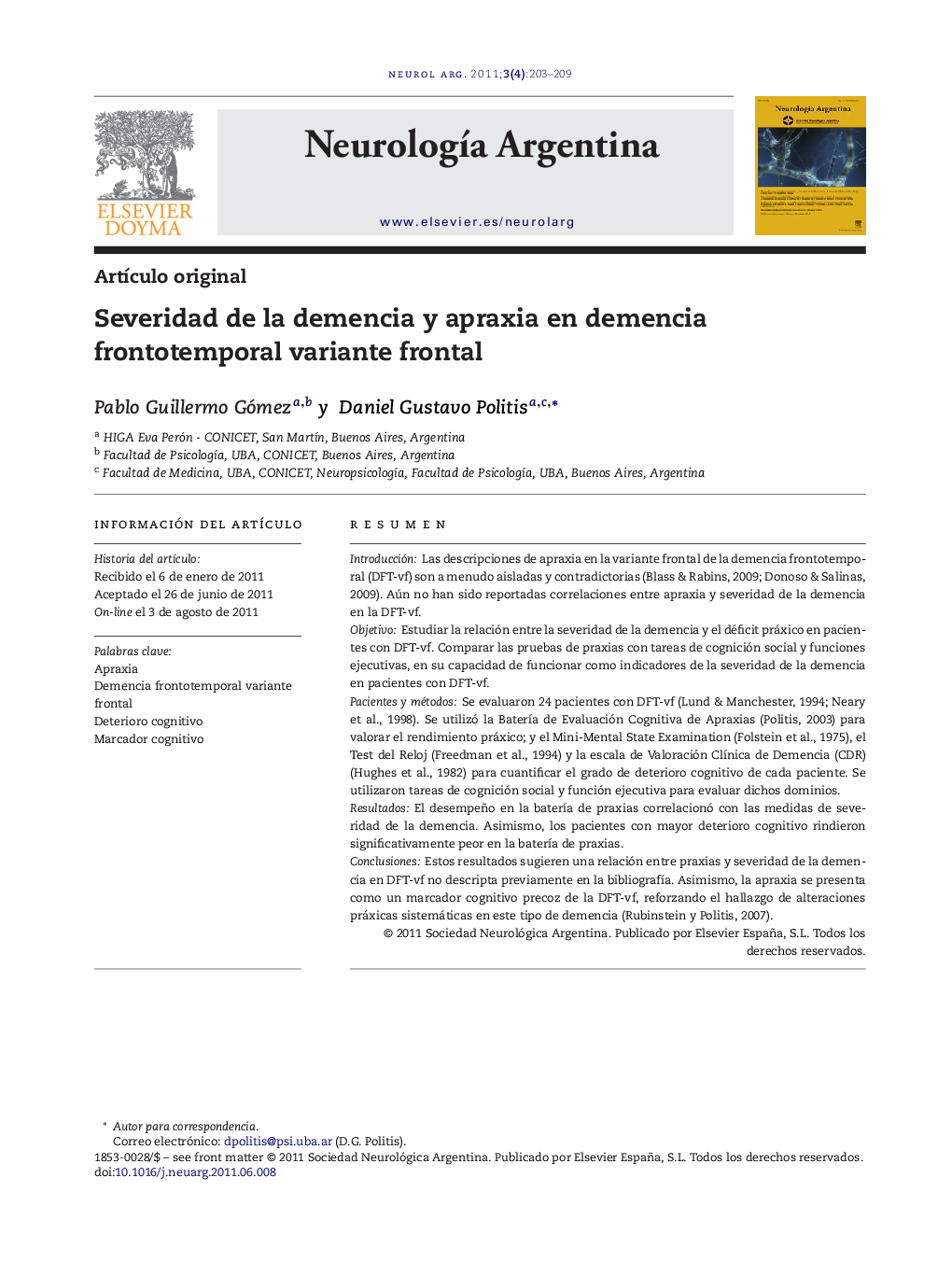| کد مقاله | کد نشریه | سال انتشار | مقاله انگلیسی | نسخه تمام متن |
|---|---|---|---|---|
| 3076890 | 1189108 | 2011 | 7 صفحه PDF | دانلود رایگان |

ResumenIntroducciónLas descripciones de apraxia en la variante frontal de la demencia frontotemporal (DFT-vf) son a menudo aisladas y contradictorias (Blass & Rabins, 2009; Donoso & Salinas, 2009). Aún no han sido reportadas correlaciones entre apraxia y severidad de la demencia en la DFT-vf.ObjetivoEstudiar la relación entre la severidad de la demencia y el déficit práxico en pacientes con DFT-vf. Comparar las pruebas de praxias con tareas de cognición social y funciones ejecutivas, en su capacidad de funcionar como indicadores de la severidad de la demencia en pacientes con DFT-vf.Pacientes y métodosSe evaluaron 24 pacientes con DFT-vf (Lund & Manchester, 1994; Neary et al., 1998). Se utilizó la Batería de Evaluación Cognitiva de Apraxias (Politis, 2003) para valorar el rendimiento práxico; y el Mini-Mental State Examination (Folstein et al., 1975), el Test del Reloj (Freedman et al., 1994) y la escala de Valoración Clínica de Demencia (CDR) (Hughes et al., 1982) para cuantificar el grado de deterioro cognitivo de cada paciente. Se utilizaron tareas de cognición social y función ejecutiva para evaluar dichos dominios.ResultadosEl desempeño en la batería de praxias correlacionó con las medidas de severidad de la demencia. Asimismo, los pacientes con mayor deterioro cognitivo rindieron significativamente peor en la batería de praxias.ConclusionesEstos resultados sugieren una relación entre praxias y severidad de la demencia en DFT-vf no descripta previamente en la bibliografía. Asimismo, la apraxia se presenta como un marcador cognitivo precoz de la DFT-vf, reforzando el hallazgo de alteraciones práxicas sistemáticas en este tipo de demencia (Rubinstein y Politis, 2007).
IntroductionThe descriptions of apraxia in frontal variant of frontotemporal dementia (fvFTD) are often isolated and contradictory (Blass & Rabins, 2009; Donoso & Salinas, 2009). Have not yet been reported correlations between apraxia and severity of dementia in fvFTD.ObjectiveTo study the relationship between the severity of dementia and the apraxia in patients with fvFTD. Compare praxis tests with social cognition and executive functions tasks in their ability to function as indicator of the severity of dementia in patients with fvFTD.Patients and methodsHave been evaluated 24 patients with vfFTD (Lund & Manchester, 1994; Neary et al., 1998). We used the Cognitive Battery Assessment of Apraxias (Politis, 2003) to assess the praxis performance, and the Mini-Mental State Examination (Folstein et al., 1975), Test Clock (Freedman et al., 1994) and Clinical Dementia Rating (CDR) (Hughes et al., 1982) to quantify the degree of cognitive impairment for each patient. It was used social cognition and executive function tasks to assess these domains.ResultsPerformance on praxis battery correlated with measures of severity of dementia. In turn, patients with greater cognitive impairment have performed significantly worse in the praxis battery.ConclusionsThese results suggest a relationship between apraxia and severity of dementia in vfFTD, not previously described in the literature. Also, the apraxia is presented as an early cognitive marker of vfFTD, reinforcing the finding of systematical praxic alterations on this type of dementia (Rubinstein and Politis, 2007).
Journal: Neurología Argentina - Volume 3, Issue 4, October–December 2011, Pages 203–209